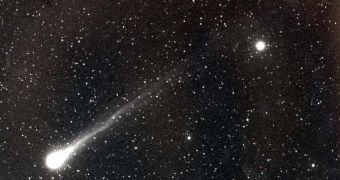The past civilizations on Earth mostly regarded the comets as messengers of destruction and rarely as bringers of good or prosperity, while the scientists today think they might have played a key role in the formation of our planet and view them as carriers of possible information about the galaxy, and the formation of the solar system.
These dusty-icy objects were presumed to have delivered the water on Earth during collisions with our planet, but when comparing water collected from comets and that existing on our planet, the theory was quickly scrapped as the hydrogen isotope ration did not match as expected. Thus it is highly unlikely that comets coming from the Kuiper belt which lies beyond the orbit of Neptune, from the Oort cloud, might have intersected Earth's orbit. Nevertheless, in the last years, astronomers observed multiple comets coming from beyond the asteroid belt, thus a future hydrogen isotopes level comparison might reveal a close match to that of the water present on Earth. According to David Jewitt from the University of Hawaii, for all we know, the water in our oceans could be a mixture of different types of water coming from all the remote regions of the solar system, and maybe the galaxy.
If you wonder where the comets are coming from, you might find yourself disappointed to find out that not even astronomers know for sure. In the early 1930 an Estonian astronomer proposed a structure formed of billions of comets which lie beyond the Kuiper belt. However, the theoretical structure one light year in radius equivalent to a quarter of the distance to the nearest star to the Sun, Proxima Centauri, has not been detected yet. The Oort cloud, as it is known, might be the origin of the long period comets coming in the inner regions of the solar system, albeit calculations show the this scenario is very unlikely.
The same problem arose with the comets that have short periods and are thought to originate in the Kuiper belt. Previous theories about their formation suggested that they might have formed out of the protoplanetary disk of matter spinning around the Sun, in the early stages of the solar system formation, and they might have preserved crucial information from that past. But even this presumption seems to be flawed since, when entering the inner regions of the solar system, they often interact with other objects and the solar wind that affects their mass, shape and the rotation on their axis.
Most of us believe that these icy objects have periodic orbits around the Sun, ever since the solar system formation process. Think again, if that had been the case, than in more than 4 billions of years orbiting around the Sun and coming in the inner regions of the solar system they should have lost their icy features only after a few millennia.
Now it is mostly believed they could have been shaded from the solar wind action by large amounts of dust which are eject during an interaction with another comet or asteroid, revealing their ice that creates large cometary Tails as they come into the vicinity of the Sun.
Since the Kuiper belt seems to be an unlikely origin point of the short-period comets, and the Oort belt mostly remains a theoretical structure, astronomers take into consideration the possibility of existence of interstellar comets, ejected from a neighboring solar system towards our own. However, this theory has been once dismissed as more than 99 percent of the comets would have executed a fly-by around their star and ejected into interstellar space, never to be seen again.
David Jewitt believes that although such comets have never been seen before, they would reveal their presence in the near future. Nevertheless, at the end of the day if you think about it, except their general composition and the orbits of a few such objects, we know close to nothing about comets.

 14 DAY TRIAL //
14 DAY TRIAL //